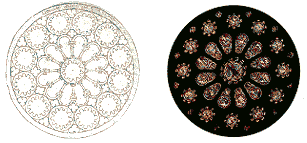
Gothic Design
Learn More.
| HOME Feature Articles Stone Carver's Tour Virtual Cathedral Cathedral Tours Gothic Field Guide GOTHIC GEOMETRY Virtual Abbey Medieval Art Tours Castle Tours Links Resources About The Site FAQ |
|
Chapter 2. Stained Glass: Painting With Light
Gothic architecture really began in the 12th century with Abbot Suger, who in his description of the ideal church wanted to fill his Abbey Church of St. Denis, near Paris, with "the most radiant windows." In contrast to the dark and somber Romanesque style that had gone before, Suger believed worshipers would feel uplifted and closer to God when surrounded by light. From this one inspired wish, architects were inspired to provide the means. Walls of Glass So with the aid of the pointed arch and the flying buttress, cathedral walls were strengthened to such a degree that spaces could be cut away for larger window casements - and thereby meet the terms of Gothic's prime directive: MORE light. The high reaches of Gothic construction came when the architect, stonecutter, ironworker and glazier pooled their skills to create the luminous rose windows of the era.
Transformed by Fire In
painting, light is reflected off the surface whereas in stained
glass, light is transmitted through the surface. For this reason,
the art of making stained glass is known as painting with light.
In
the hands of medieval glaziers, glass took on a jewel-like quality
that was all the more impressive for the ancient simplicity of
its technique: sand transformed by fire...
|
Sponsored
Links
copyright © 2017
 In
some respects, we've put the 'cart before the horse' in first
spotlighting the
In
some respects, we've put the 'cart before the horse' in first
spotlighting the 